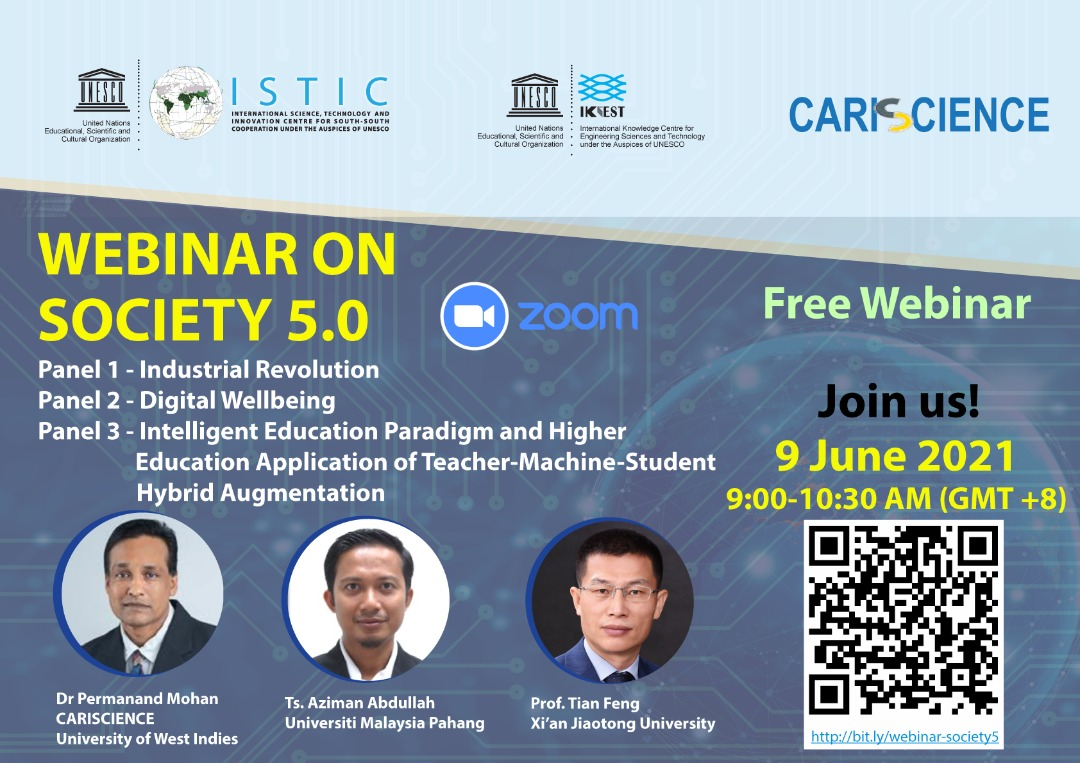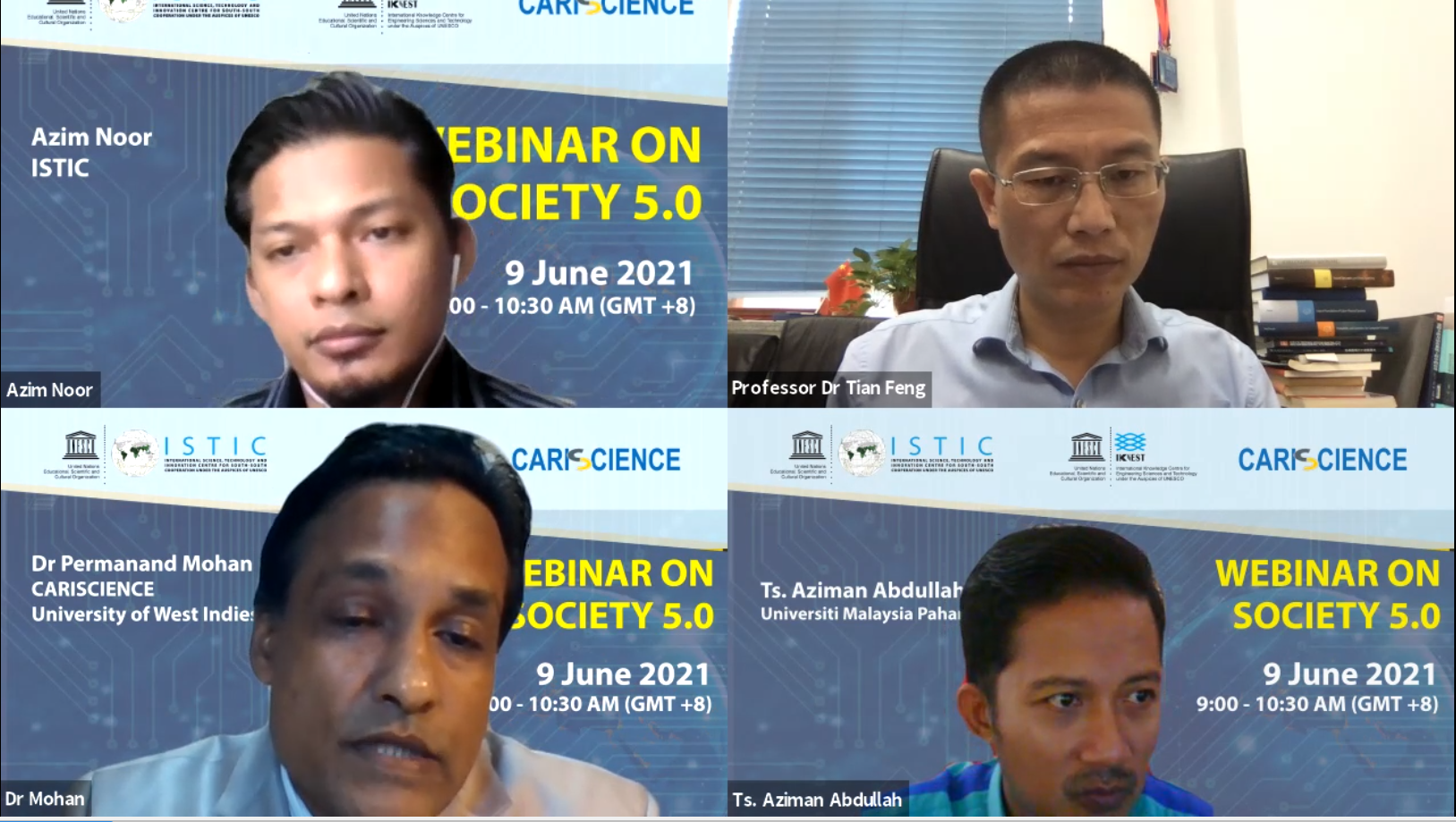
The online seminar or webinar successfully organised on 9 June 2021, about one hour and half by International Science, Technology and Innovation, Centre for South-South Cooperation under the auspices of UNESCO (ISTIC) in collaboration with International Knowledge Centre for Engineering Sciences and Technology (IKCEST), China and CARISCIENCE, Trinidad & Tobago. The webinar on Society 5.0 panel consists of Dr Permanand Mohan, a Senior Lecturer at University of the West Indies (St. Augustine Campus), Trinidad and Tobago; Ts. Aziman Abdullah, a lecturer from Universiti Malaysia Pahang, Malaysia and Professor Dr Tian Feng, a Senior Lecturer at Xi’an Jiaotong Univiersity, Xi’an, China. The webinar was moderated by Mohd Azim Noor from ISTIC.
The webinar format is 1 moderator and 3 panellists. The panellist delivers the presentation on the topics Industrial Revolution, Digital Wellbeing and the last one, Intelligent Education Paradigm and Higher Education Application of Teacher-Machine-Student Hybrid Augmentation.
59 people from 21 countries, comprised of Malaysia, Cameroon, Sri Lanka, Trinidad and Tobago, Seychelles, Pakistan, Philippines, Egypt, China, Nigeria, Indonesia, Oman, India, Jamaica, Morocco, Jordan, Zimbabwe, Sudan, Uganda, Bangladesh and Palestine attended the Webinar. 32 Male and 27 Female.
Society 5.0 is a human-centred society that balances economic and technological advancement to solve society's problems with super-smart AI data systems. It represents a new perspective for a more intelligent society where humans, nature, and technology create a sustainable balance enhanced by data. The concept of Society 5.0 was first proposed by the Japanese government in the 5th Science and Technology Basic Plan as a future society that Japan should aspire to. It follows the hunting society (Society 1.0), agricultural society (Society 2.0), industrial society (Society 3.0), and information society (Society 4.0).
The basic schema of Society 5.0 is that data are collected from the "real world" and processed by computers, with the results being applied in the real world. It underlies the systems responsible for keeping our homes adequately supplied with electricity and those that keep the trains running on time. This mechanism relies on computerized automated controls. When people use the term "information society," they mean a society in which each of these systems collects data, processes them and then applies the results in a particular real-world environment.
So, what makes Society 5.0 different? Instead of having each system operating within a limited scope, such as keeping a room comfortable, supplying energy, or ensuring that the trains run on time, Society 5.0 will have systems that operate throughout society in an integrated fashion. Since the Society 5.0 term coined by the Japanese government, the primary reference is from Japanese sources. This paper explores a prospective model of science, technology and innovation (STI) activities in Society 5.0 from an ecosystem perspective. STI policy review and statistical analysis are conducted in comparison with Germany and the United States to describe the historical transformation of Japan's STI ecosystem. Significant socio-economic risks on Japan's STI ecosystem can be classified as labour, capital and spatial risks.
Industrial Revolution
The first panelist present on the Society 5.0 and Industrial Revolution. The story begins with Society 1.0, the hunting society which started during the age of stone. It follows the agricultural society (Society 2.0), industrial society (Society 3.0), and information society (Society 4.0). As we know, the Society 5.0 is the outcome of the Industrial Revolution 4.0. In the industrial Revolution 4.0, there is technology elements such as Big Data, Internet of Things (IoT), Industrial IoT, Cloud Computing, Artificial Intelligence and Machine Learning. The speaker mentioned about the Industrial Revolution 1.0, mechanization and steam power, Industrial Revolution 2.0, mass production, assembly line and electrical energy. the Industrial Revolution 3.0, automation, computers and electronics and the Industrial Revolution 4.0, cyber physical systems. Industry 4.0 is a vision that evolved from an initiative in 2011 to make the German manufacturing industry more competitive (‘Industrie 4.0’). It involves the digital transformation of manufacturing/production and related industries and value creation processes. Industry 4.0 refers to the convergence and application of nine digital technologies which is Big Data, Autonomous Robots, Internet of things (IOT), Cloud Computing, Artificial Intelligence, Cybersecurity, Augmented reality (AR) and Virtual reality (VR), Additive Manufacturing and Systems Integration. Industry 4.0 is already here although it is co-existing with Industry 2.0 and Industry 3.0 in some countries. Its goal is to revolutionize industrial production. The current society will become the Society 5.0 when they can fully utilize the digital technologies in Industry 4.0 specially to leverage the technologies on production, industries, manufacturing, agriculture, logistics and services. The vision of Society 5.0 is for economic advancement while solving key social problems and allowing people to live diverse lifestyles and pursue happiness in their own ways. The key enabler for both Industry 4.0 and Society 5.0 is digital transformation. The ICT infrastructure such as the fast internet connectivity like 5G network needed to accelerate the digital transformation.
Digital Wellbeing
The second panelist talks about the Digital Wellbeing and Society 5.0. Digital Wellbeing can be defined as the effect of engagement with digital technologies. Digital wellbeing is the impact of digital technology engagement that potentially harm human well-being with adverse effects. As human, the ultimate goals are to live well, but how well we live with our daily routine as a worker or student etcetera with or without the digital technologies. The digital technologies can contribute to a lot of health risk, such as myopia, cardiovascular, kidney problem etcetera because of the excessive screen time and lack of sleep or rest. The current generation likes to stare on the screen for a long period for the social media, entertainment, and information, without concerning of their own wellbeing. For this, all ages affected by this problem if left uncontrolled, whether its children, adolescent, adults, or elderly. This problem happening throughout the world especially, in the country with good internet infrastructure. The speaker advises, occasionally need to do digital detox, like doing other activities such as gardening. For the case study, the panelist takes the implementation and use of Learning Management Systems (LMS) at his university as example. Adopting online learning through LMS is one of the key digitalization strategies in higher education. The Society 5.0 is to make sure the technology brings benefits to human and convey the meaning of humanity. Learning experience in education system is the means how the future society will be shaped into, either being well with humanity.
Intelligent Education Paradigm and Higher Education Application of Teacher-Machine-Student Hybrid Augmentation.
The third panellist talk about the case study of Society 5.0: Intelligent education paradigm and higher education application of Teacher-Machine-Student hybrid augmentation. The panellist mentioned, the challenge that world is experiencing a great change that has not existed for 100 years. The merging of humanity society and physical space with cyber space. The development trend of human society, where the merging of 3 aspects called as Ternary world, according to the panellist. The changes also affected the future of works, the future career will be based on digital technologies, careers also replaced by Artificial Intelligence. The panellist keep mention about the challenge which will be face by teacher.
The next challenge is urgent need to a system to guide teacher development because machine is not intelligent enough to deal with all of teacher’s routines. According to the panellist, there are four major difficulties for Artificial Intelligence (AI) to do the task of teacher which is, difficult to precisely collect the data, difficult to precisely assess Teaching Quality, difficult to precisely guide teachers’ development, and difficult to precisely assist students. The panellist presents with the Intelligent education paradigm of hybrid augmentation which with the goals integrating the advantages of human beings in common sense, intuition, reasoning, decision-making, and machines in memory, calculation, search, and optimization, expand the dual cognitive structure of teachers-students into a ternary compound subject of teacher-machine-student, and realize the collaborative evolution, mutual adaptation, and spiral cognitive enhancement of the three. This paradigm explains the need to have an infrastructure and systems to provide the platform/machine where the students can get lessons and advise while the teacher also can teach and monitor the students. This includes a Big Data platform for creating new system for cultivating students with ‘four precise’ (data collection, assessment, supervision, and assistance). The use of Internet of Things (IoT) and Cloud Computing to collect and analyse the data. This big project like a super smart campus to sync with the Society 5.0.
Society 5.0 is a human-centred and super-smart society, which makes use the convergence technology to improve wellbeing. The various information and communication technology infrastructure will enable all the applications and strategy to make human lives better by merging the cyber and physical space. During the Question-and-Answer session, about 7 questions from the attendees answered by the panellists.

The moderator and panellists on the online platform Zoom Cloud Meeting.
Original Text (This is the original text for your reference.)

The online seminar or webinar successfully organised on 9 June 2021, about one hour and half by International Science, Technology and Innovation, Centre for South-South Cooperation under the auspices of UNESCO (ISTIC) in collaboration with International Knowledge Centre for Engineering Sciences and Technology (IKCEST), China and CARISCIENCE, Trinidad & Tobago. The webinar on Society 5.0 panel consists of Dr Permanand Mohan, a Senior Lecturer at University of the West Indies (St. Augustine Campus), Trinidad and Tobago; Ts. Aziman Abdullah, a lecturer from Universiti Malaysia Pahang, Malaysia and Professor Dr Tian Feng, a Senior Lecturer at Xi’an Jiaotong Univiersity, Xi’an, China. The webinar was moderated by Mohd Azim Noor from ISTIC.
The webinar format is 1 moderator and 3 panellists. The panellist delivers the presentation on the topics Industrial Revolution, Digital Wellbeing and the last one, Intelligent Education Paradigm and Higher Education Application of Teacher-Machine-Student Hybrid Augmentation.
59 people from 21 countries, comprised of Malaysia, Cameroon, Sri Lanka, Trinidad and Tobago, Seychelles, Pakistan, Philippines, Egypt, China, Nigeria, Indonesia, Oman, India, Jamaica, Morocco, Jordan, Zimbabwe, Sudan, Uganda, Bangladesh and Palestine attended the Webinar. 32 Male and 27 Female.
Society 5.0 is a human-centred society that balances economic and technological advancement to solve society's problems with super-smart AI data systems. It represents a new perspective for a more intelligent society where humans, nature, and technology create a sustainable balance enhanced by data. The concept of Society 5.0 was first proposed by the Japanese government in the 5th Science and Technology Basic Plan as a future society that Japan should aspire to. It follows the hunting society (Society 1.0), agricultural society (Society 2.0), industrial society (Society 3.0), and information society (Society 4.0).
The basic schema of Society 5.0 is that data are collected from the "real world" and processed by computers, with the results being applied in the real world. It underlies the systems responsible for keeping our homes adequately supplied with electricity and those that keep the trains running on time. This mechanism relies on computerized automated controls. When people use the term "information society," they mean a society in which each of these systems collects data, processes them and then applies the results in a particular real-world environment.
So, what makes Society 5.0 different? Instead of having each system operating within a limited scope, such as keeping a room comfortable, supplying energy, or ensuring that the trains run on time, Society 5.0 will have systems that operate throughout society in an integrated fashion. Since the Society 5.0 term coined by the Japanese government, the primary reference is from Japanese sources. This paper explores a prospective model of science, technology and innovation (STI) activities in Society 5.0 from an ecosystem perspective. STI policy review and statistical analysis are conducted in comparison with Germany and the United States to describe the historical transformation of Japan's STI ecosystem. Significant socio-economic risks on Japan's STI ecosystem can be classified as labour, capital and spatial risks.
Industrial Revolution
The first panelist present on the Society 5.0 and Industrial Revolution. The story begins with Society 1.0, the hunting society which started during the age of stone. It follows the agricultural society (Society 2.0), industrial society (Society 3.0), and information society (Society 4.0). As we know, the Society 5.0 is the outcome of the Industrial Revolution 4.0. In the industrial Revolution 4.0, there is technology elements such as Big Data, Internet of Things (IoT), Industrial IoT, Cloud Computing, Artificial Intelligence and Machine Learning. The speaker mentioned about the Industrial Revolution 1.0, mechanization and steam power, Industrial Revolution 2.0, mass production, assembly line and electrical energy. the Industrial Revolution 3.0, automation, computers and electronics and the Industrial Revolution 4.0, cyber physical systems. Industry 4.0 is a vision that evolved from an initiative in 2011 to make the German manufacturing industry more competitive (‘Industrie 4.0’). It involves the digital transformation of manufacturing/production and related industries and value creation processes. Industry 4.0 refers to the convergence and application of nine digital technologies which is Big Data, Autonomous Robots, Internet of things (IOT), Cloud Computing, Artificial Intelligence, Cybersecurity, Augmented reality (AR) and Virtual reality (VR), Additive Manufacturing and Systems Integration. Industry 4.0 is already here although it is co-existing with Industry 2.0 and Industry 3.0 in some countries. Its goal is to revolutionize industrial production. The current society will become the Society 5.0 when they can fully utilize the digital technologies in Industry 4.0 specially to leverage the technologies on production, industries, manufacturing, agriculture, logistics and services. The vision of Society 5.0 is for economic advancement while solving key social problems and allowing people to live diverse lifestyles and pursue happiness in their own ways. The key enabler for both Industry 4.0 and Society 5.0 is digital transformation. The ICT infrastructure such as the fast internet connectivity like 5G network needed to accelerate the digital transformation.
Digital Wellbeing
The second panelist talks about the Digital Wellbeing and Society 5.0. Digital Wellbeing can be defined as the effect of engagement with digital technologies. Digital wellbeing is the impact of digital technology engagement that potentially harm human well-being with adverse effects. As human, the ultimate goals are to live well, but how well we live with our daily routine as a worker or student etcetera with or without the digital technologies. The digital technologies can contribute to a lot of health risk, such as myopia, cardiovascular, kidney problem etcetera because of the excessive screen time and lack of sleep or rest. The current generation likes to stare on the screen for a long period for the social media, entertainment, and information, without concerning of their own wellbeing. For this, all ages affected by this problem if left uncontrolled, whether its children, adolescent, adults, or elderly. This problem happening throughout the world especially, in the country with good internet infrastructure. The speaker advises, occasionally need to do digital detox, like doing other activities such as gardening. For the case study, the panelist takes the implementation and use of Learning Management Systems (LMS) at his university as example. Adopting online learning through LMS is one of the key digitalization strategies in higher education. The Society 5.0 is to make sure the technology brings benefits to human and convey the meaning of humanity. Learning experience in education system is the means how the future society will be shaped into, either being well with humanity.
Intelligent Education Paradigm and Higher Education Application of Teacher-Machine-Student Hybrid Augmentation.
The third panellist talk about the case study of Society 5.0: Intelligent education paradigm and higher education application of Teacher-Machine-Student hybrid augmentation. The panellist mentioned, the challenge that world is experiencing a great change that has not existed for 100 years. The merging of humanity society and physical space with cyber space. The development trend of human society, where the merging of 3 aspects called as Ternary world, according to the panellist. The changes also affected the future of works, the future career will be based on digital technologies, careers also replaced by Artificial Intelligence. The panellist keep mention about the challenge which will be face by teacher.
The next challenge is urgent need to a system to guide teacher development because machine is not intelligent enough to deal with all of teacher’s routines. According to the panellist, there are four major difficulties for Artificial Intelligence (AI) to do the task of teacher which is, difficult to precisely collect the data, difficult to precisely assess Teaching Quality, difficult to precisely guide teachers’ development, and difficult to precisely assist students. The panellist presents with the Intelligent education paradigm of hybrid augmentation which with the goals integrating the advantages of human beings in common sense, intuition, reasoning, decision-making, and machines in memory, calculation, search, and optimization, expand the dual cognitive structure of teachers-students into a ternary compound subject of teacher-machine-student, and realize the collaborative evolution, mutual adaptation, and spiral cognitive enhancement of the three. This paradigm explains the need to have an infrastructure and systems to provide the platform/machine where the students can get lessons and advise while the teacher also can teach and monitor the students. This includes a Big Data platform for creating new system for cultivating students with ‘four precise’ (data collection, assessment, supervision, and assistance). The use of Internet of Things (IoT) and Cloud Computing to collect and analyse the data. This big project like a super smart campus to sync with the Society 5.0.
Society 5.0 is a human-centred and super-smart society, which makes use the convergence technology to improve wellbeing. The various information and communication technology infrastructure will enable all the applications and strategy to make human lives better by merging the cyber and physical space. During the Question-and-Answer session, about 7 questions from the attendees answered by the panellists.

The moderator and panellists on the online platform Zoom Cloud Meeting.










 User Center
User Center My Training Class
My Training Class Feedback
Feedback












Comments
Something to say?
Login or Sign up for free